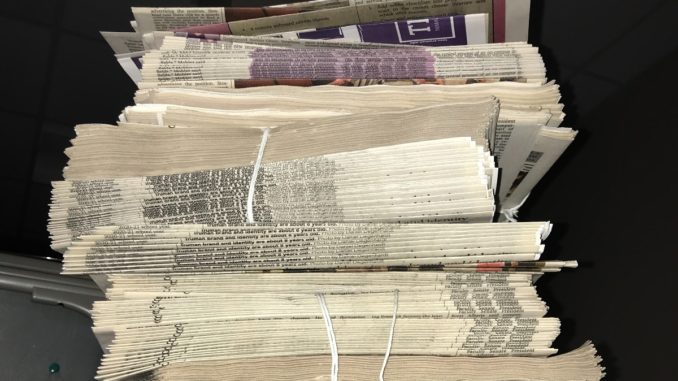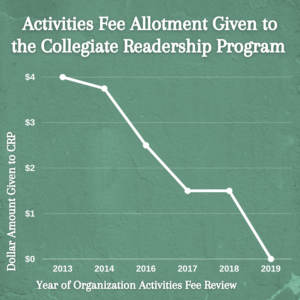
During the 2019-20 school year, the student body voted on a resolution to defund the Collegiate Readership Program and halt the delivery of national newspapers to Truman State University’s campus.
The CRP has had a long battle with the Organization Activities Fee review committee and Student Government that started in 2013. The OAF review committee is a Student Government-appointed group that recommends changes to the funding of certain programs and organizations. During the 2013-14 academic year, the committee decreased the fee allotted to the CRP from the Student Activities Fee, citing a surplus of money saved as the reason.
The budget was slashed again during the 2016-17 meeting of the OAF. The fee allotted to the CRP was decreased from $3.75 to $1.50. Again, the reason for the decrease was a surplus of money. The committee intended to run off the surplus until the next OAF review could reevaluate the CRP.
By the time these decreases in fee allotment were in place and the 2019-20 OAF review committee met for discussion, the CRP was running a deficit and was in danger of exhausting its funds by fall 2020.
Student Government President Katie Alexander explained that with the current funding that the CRP was receiving, there would only be about a month’s worth of newspapers delivered for the fall 2020 semester.
“So with the $1.50 that students would have been spending on [the CRP] this year, we would have had about a month of printed newspapers,” Alexander said. “We decided to recommend ceasing the funding of the program because if we asked students to fund it, there would be almost no service for them for the year, so that would be a waste of their money.”
This scenario is based upon the idea that the CRP would’ve continued to receive the unsustainable $1.50 it had been allotted.
Adam Barker, Student Government representative for the 2019-20 OAF review committee, said lack of funding was not the only reason for the CRP’s recommendation for termination.
A survey was emailed to all students during the spring 2020 semester that included questions asking about their familiarity with the CRP.
Barker said the important part of the survey was the question of whether or not students would be more likely to utilize an online news service rather than a physical one, with 78.3% responding yes.
When asked their opinion about the statement, “I feel that it is important to continue the Collegiate Readership Program,” more students agreed than disagreed. Twenty-eight percent of students said that they somewhat or strongly disagreed and 42% said that they somewhat or strongly agreed, leaving out the 29% that had no opinion.
It’s important to understand that the Student Government passed a resolution during the 2018-19 school year, Barker explained, recommending the movement from physical newspapers to an online news source.
In spring 2020, students voted on the defunding of the CRP. Two hundred and eighty-six people voted for this measure in total, a little over 5% of the student population, with 197 votes in favor of the defunding and 89 votes against. Assuming all of the 2019-20 Student Government members, with a population of around 30, voted within this election while following their own recommendations for defunding, 10% of the vote was already locked in support of defunding.
Although the ballot measure to defund the CRP was added, there was no measure to enact any kind of online alternative. According to the OAF resolution recommending the defunding, there was not enough time to “adequately gauge student interest and opinion regarding an online-based subscription.”
Gavin Arnold, the student-at-large for the 2019-20 OAF review committee, said there was a lot more to be evaluated about the online CRP alternative than what the OAF committee was able to accomplish.
“We just wanted to give more time for a proper evaluation to occur — to see how many students would use an online program and what that would cost,” Arnold said.
Based on research done by the 2019-20 OAF committee, the amount needed for both undergraduate and graduate students to receive an online subscription to the New York Times would cost $15,114.40/year or $2.67/student.
The implementation of an online news source is not completely new to Truman’s campus. In 2015 “The Buzz,” an app that combined the news of USA Today and The Index, was introduced and quickly scrapped the next year due to lack of interest and awareness.
After “The Buzz” was shut down, the 2017 OAF committee recognized the time and resources that were put into the app by TMN yet declined to allot the funds from “The Buzz” to the organization, citing that the fee is “not to supplement a lack of funding in the Communication Department.”
Changes have been made to the OAF review counsel starting this year and a review will now happen every year instead of every 3 years. Barker said this allows the committee to spend more time and attention on individual programs.
“[This year] it’s going to be talking more about the project-based fees that go towards different projects and policies on Truman’s campus,” Barker said. “We’re not focusing on the organizations this year which I think is going to help.”
Barker said if anyone has any opinions on the CRP or Student Government matters in general, they should contact a Student Government representative.
“We are more than willing to listen and talk with you to make your voice heard,” Barker said.
